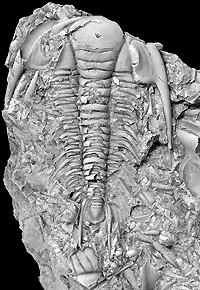Paradoxides paradoxissus

Paradoxides paradoxissus
Paradoxides paradoxissimus (Wahlenberg, 1818) was the trilobite arthropod Paradoxides, a vagrant benthic hunter.
Paradoxides paradoxissimus is one of the largest animals known to have lived in the seas of half a billion years ago. The genus has become a kind of emblem of marine life in the middle Cambrian period. Paradoxides. paradoxissimus is the type species of the genus.
Paradoxides paradoxissimus have been found at many localities in Scandinavia, but nearly all are isolated sclerites. Entire specimens are very rare.
Paradoxides paradoxissimus could probably swim, but it is mostly found associated with benthic faunas of the outer shelf. Most trilobites could protect themselves by rolling up like an armadillo, but Paradoxides may have had to rely on its size for defence.
Species detail
-
Taxonomy
Underlying the front part of the head is the hypostome, a large plate which is, in P. paradoxissimus, fused to the rostral plate a structure is thought to be associated with a predatory mode of life. Learn more about the distinguishing characteristics of Paradoxides paradoxissimus.
-
Distribution and habitat
Paradoxides paradoxissimus have been found at many localities in Scandinavia, but nearly all are isolated sclerites. Entire specimens are very rare. Find out more about where these trilobites are found.
-
Behaviour
Paradoxides paradoxissimus could probably swim, but it is mostly found associated with benthic faunas of the outer shelf. Learn more about the defence behaviour of Paradoxides paradoxissimus.
-
Stratigraphy
Paradoxides paradoxissimus is found in sandstones, dark mudstones and limestones. Stratigraphically, it is particularly characteristic of the middle part of the Middle Cambrian. Discover more about the stratigraphy of Paradoxides paradoxissimus.
Author
Adrian Rushton
Toolbox
Naming
- Linnaeus termed them Entomolithus paradoxus, meaning “stone insect – against expectation” and assigned Greek letters to the species he recognised.
- Trilobites were known to Linnaeus, but not well understood.
- One of his specimens was a large, rather broad-bodied Paradoxides now held in Copenhagen.
- Wahlenberg recognised a narrow-bodied form he dubbed it Entomolithus paradoxissimus.
- Brongniart devised the generic name Paradoxides from Linnaeus’s “paradoxus”